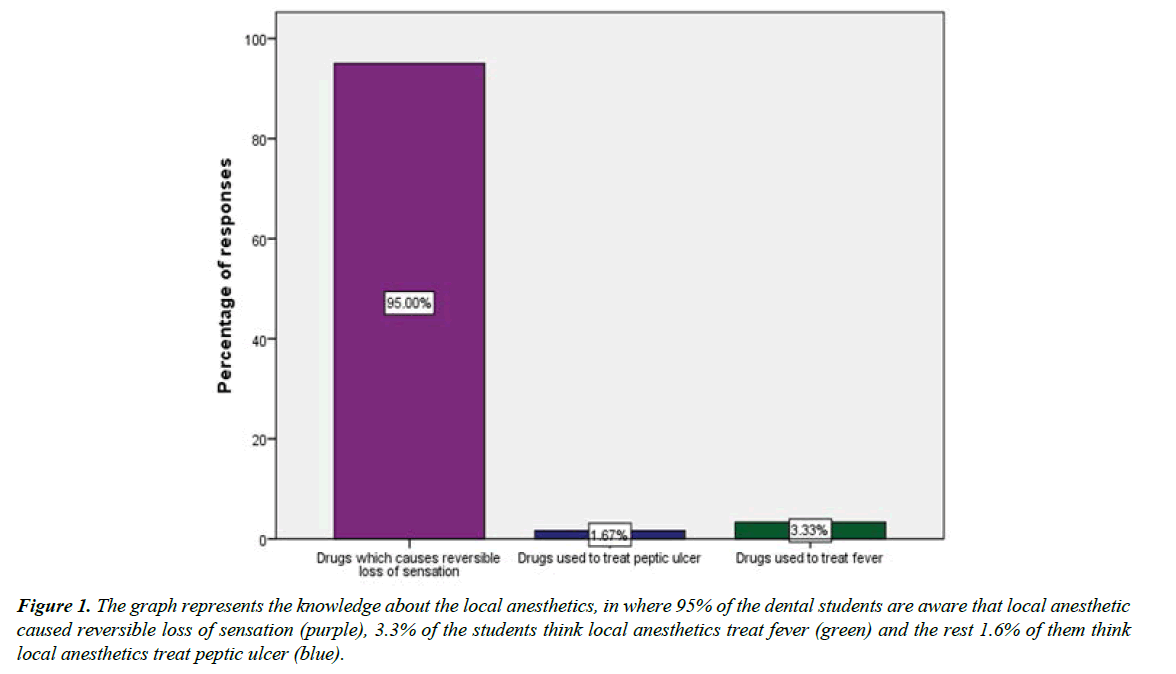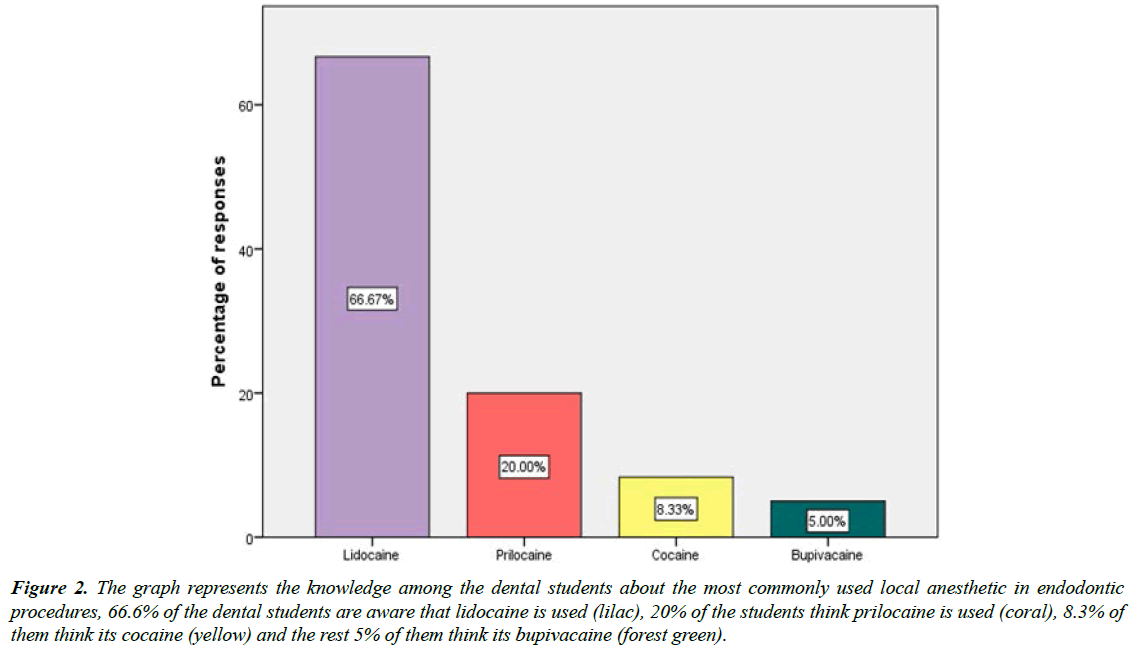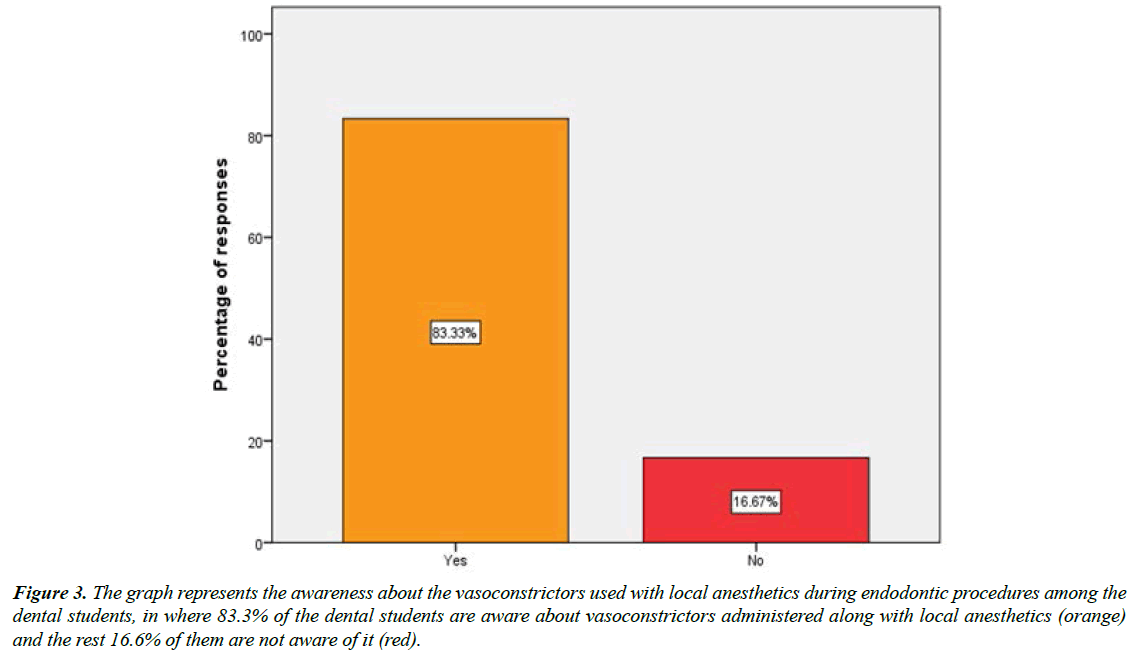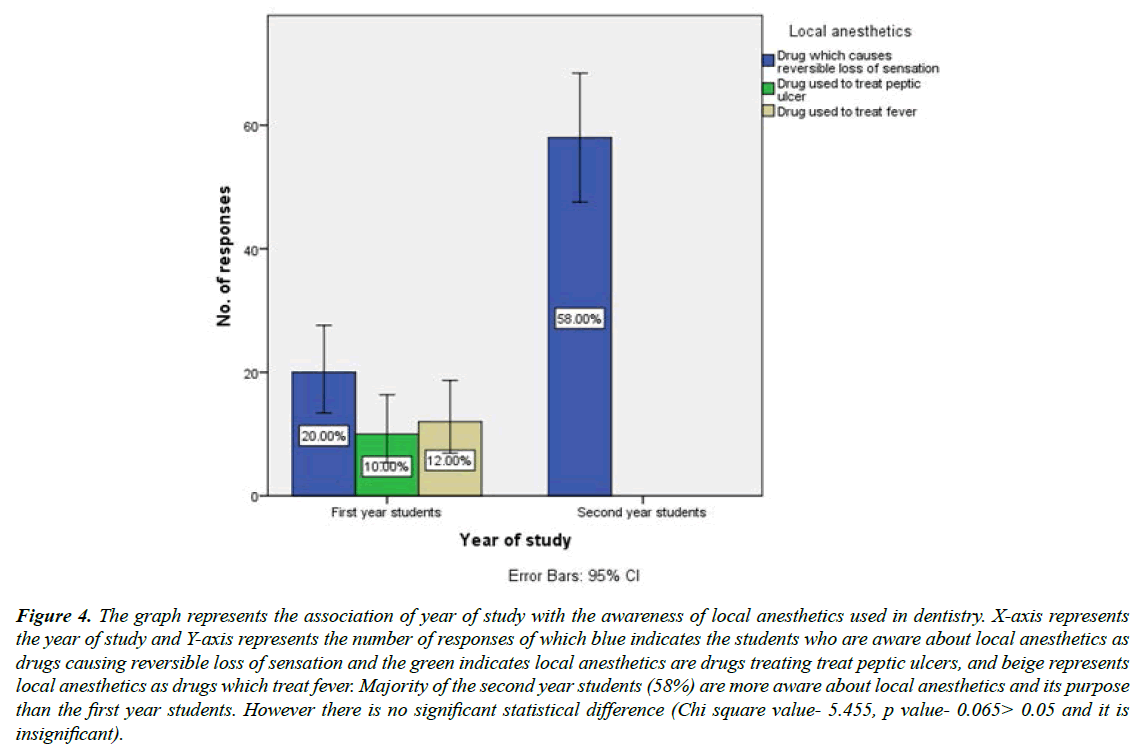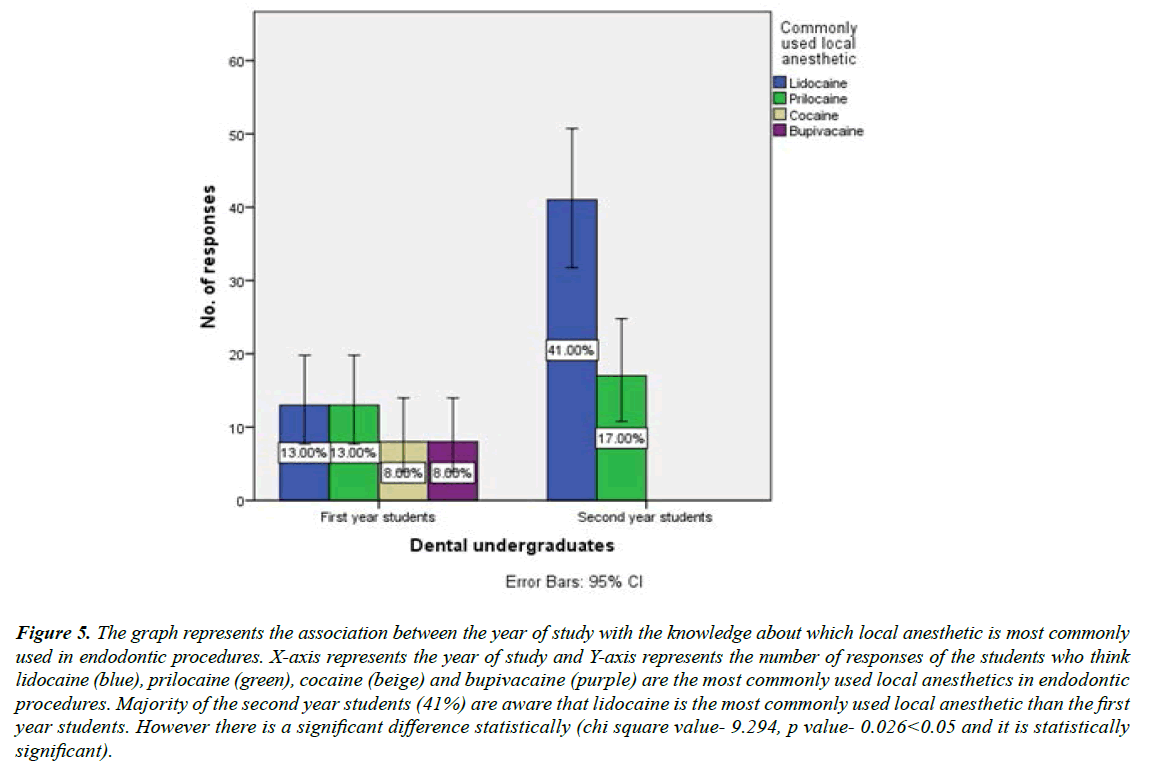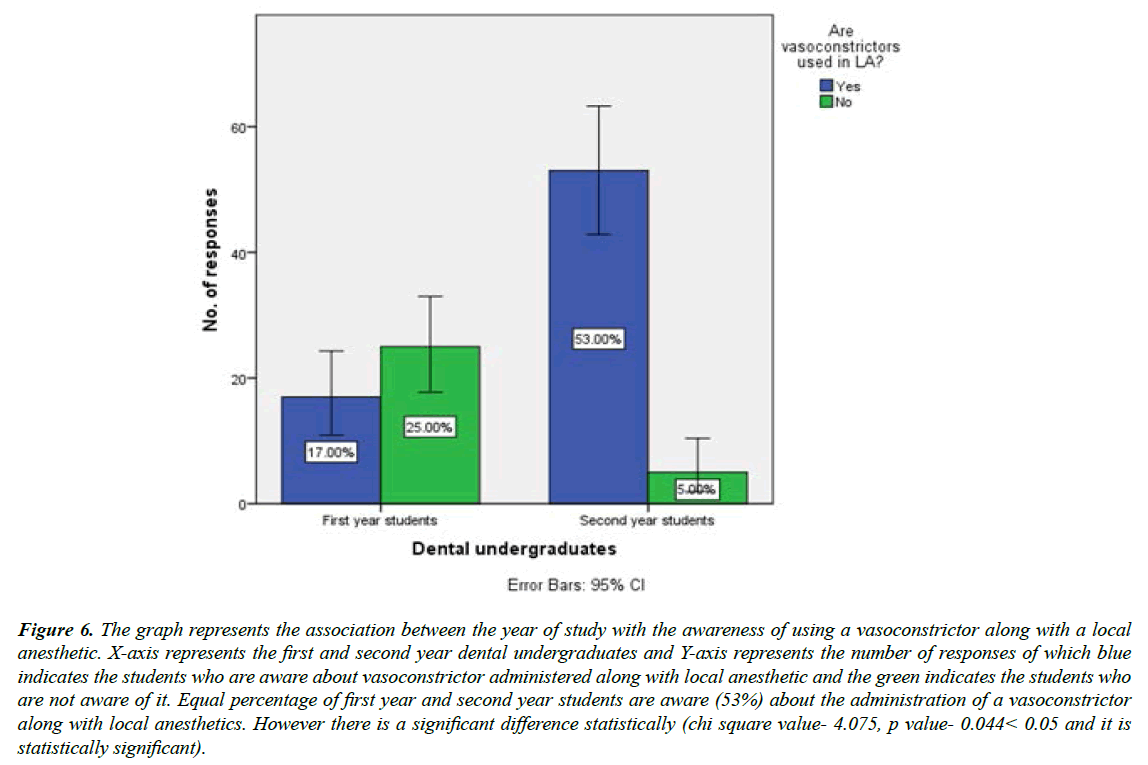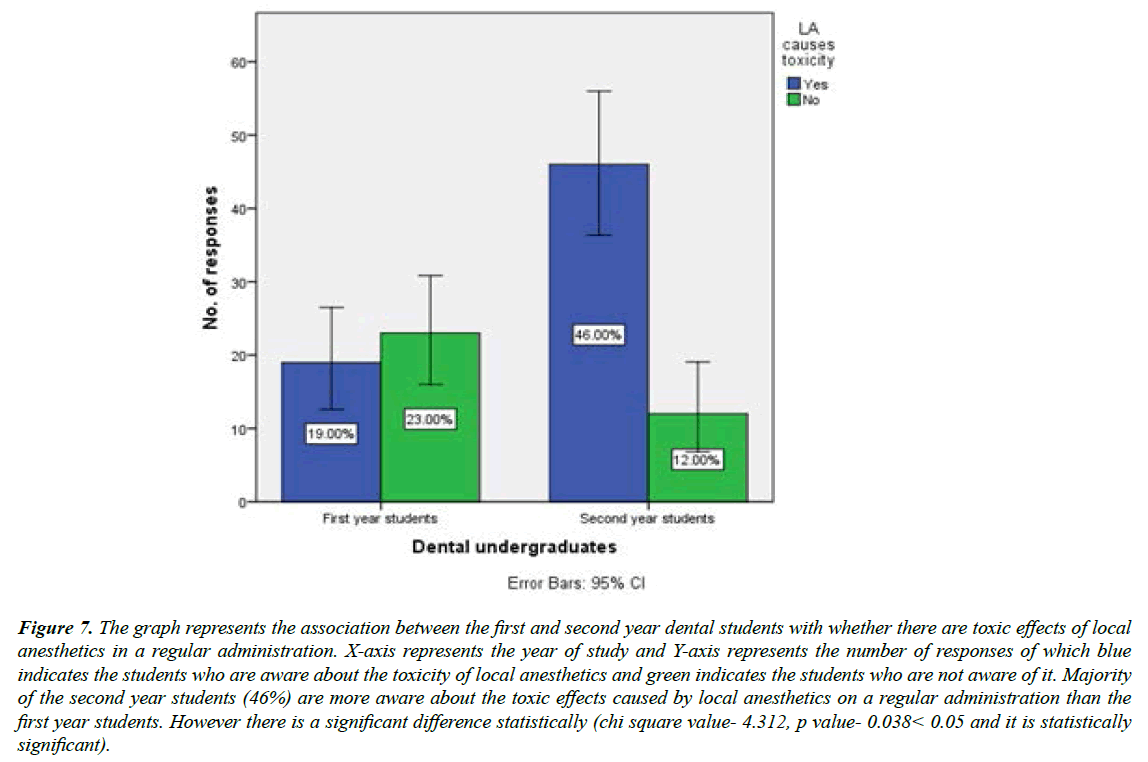Research Article - Journal of Pain Management and Therapy (2022) Volume 6, Issue 3
Knowledge and awareness about local anesthetics used in endodontic procedures among dental students.
Taanya Imtiaz, Akshay Khandelwal*Department of Conservative Dentistry and Endodontics, Saveetha Dental College and Hospital, Saveetha Institute of Medical and Technical Sciences, Saveetha University, Chennai, India
- *Corresponding Author:
- Akshay Khandelwal
Department of Conservative Dentistry and Endodontics
Saveetha Dental College and Hospital
Saveetha Institute of Medical and Technical Sciences
Saveetha University, Chennai, India
E-mail: akshayty@gmail.com
Received: 26-Apr-2022, Manuscript No. AAPMT-22-61908; Editor assigned: 28-Apr-2022, PreQC No. AAPMT-22-61908 (PQ); Reviewed: 12-May-2022, QC No. AAPMT-22-61908; Revised: 14-May-2022, Manuscript No. AAPMT-22-61908 (R); Published: 21-May-2022, DOI: 10.35841/aapmt- 6.3.111
Citation: Imtiaz T, Khandelwal A. Knowledge and awareness about local anesthetics used in endodontic procedures among dental students. J Pain Manage Ther 2022;6(3):111
Abstract
Introduction: Local anesthetics are a special group of drugs that cause reversible loss of sensation. They are the most commonly used drug in dentistry. Local anesthetics are frequently used in numerous clinical conditions which cause acute pain; it's also administered to treat chronic pain. Dental practice is the most common field that uses local anesthetics to control pain during quick yet painful procedures like the endodontic procedures. The aim of this study is to assess the knowledge about local anesthetics used in endodontic procedures among dental students. Materials and methods: Detailed questionnaire was created with 12 questions about sandblasting and was circulated to 100 dental undergraduate students through Google forms. Chi square test was used to analyze the collected data using SPSS Version 22. Results: 95% of the dental students are aware about local anesthetic causing reversible loss of sensation and their main purpose of action and the p value is 0.065> 0.05 and it is insignificant. More than 76% of them are aware it is regularly used in endodontic therapy and the p value0.038< 0.05 and it is statistically significant. And students have good knowledge of which local anesthetic is commonly used in endodontic procedures. Conclusion: Thus the present study concludes that the awareness and knowledge of local anesthetics used in endodontic procedures among dental students is good, and the various aspects of local anesthetics are well known by the dental students.
Keywords
Local anesthetics, Endodontic, Drugs, Students, Awareness, Innovative technology.
Introduction
Local anesthetics are a special group of drugs that cause reversible loss of sensation. It works by reversible blocking of the nerve impulses that diminishes the sensation of a particular peripheral area [1]. They are the most commonly used drug in dentistry. Local anesthetics are frequently used in numerous clinical conditions which cause acute pain; it's also administered to treat chronic and cancer pain [2]. Local anesthetics is the commonly used technique to relieve pain in dentistry, they are widely used in dentistry mainly in endodontic procedures to treat intraoperative pain [3]. There have been a very few complications faced by dentists using local anesthetics [4].
Local anesthetics have a specific mechanism of action which is highly applicable in case of the medical procedures. Local anesthetics prevent the permeability of the neuronal membrane by blocking the sodium sensitive channels [5,6]. Local anesthetics are specifically used when there is mechanical trauma, anoxia and prevent the painful short term procedures [7]. Their specific and reversible activities help in faster action and require duration of withstanding the local anesthetics. Dental practice is the most common field that uses local anesthetics to control pain during quick yet painful procedures like the endodontic procedures [8].
The sensory supply of the oral cavity is complex leading to many complications during a normal endodontic procedure, but the use of local anesthesia nowadays has eased the process and has given greater relief to the patients [9]. They are commonly the safest chemical drugs used in the medical cases that are generally administered topically, but this is capable of causing minor adverse effects [10]. Nausea, vomiting and restlessness being the most commonly occurring side effects. Local anesthetics are also capable of causing major systemic effects which involve the cardiovascular system because of its powerful vasoconstrictor effect [11]. So the side effects caused by local anesthetics can either be systemic or localized.
The structural nature of these drugs consists of a carbon intermediate chain and a hydrophilic and lipophilic group and has an ester or an amide link [12]. Prilocaine, articaine, lidocaine are some commonly used local anesthetics in dentistry which are available as injections [13]. Local anesthetics are mainly used in succession to prevent the inflammation of the anesthetized tooth; many dentists prevent the endodontic and other dental procedures from proceeding without the action of any local anesthesia [14]. Endodontic treatments like irreversible pulpitis and tooth extractions are commonly performed in patients who use drugs like local anesthetics to avoid intra operative and postoperative dental pain.
Thus the aim of this present study is to analyses and understands the knowledge about local anesthetics and the attitude of the dental students about the local anesthetics which are commonly used in dentistry especially in endodontic procedures.
Materials and Methods
A standardized questionnaire was created on the basis of assessing the knowledge and attitude of dental students about local anesthetics used in dentistry. The questionnaire was initially reviewed by the guide and then was approved by the Institutional Board of Review. The questionnaire was then circulated to 100 dental students through google forms using the online platforms. Knowledge towards the topic was assessed only among 100 students which was a drawback of the study. Then the data was collected in an excel sheet which was exported to SPSS version 22.0 software. Chi square test was performed for the statistical analysis. And the results were analysed and graphically represented. The dependent variables are the knowledge and awareness about the different endodontic procedures and the commonly used local anesthesia for them. The independent variable is sex and age.
Results
The responses were collected and analyzed, 95% of the dental students are aware about local anesthetic causing reversible loss of sensation, 3.3% of them think local anesthetics treat fever and the rest 1.6% of them think local anesthetics treat peptic ulcer shown in Figure 1. 76.6% of the dental students are aware that local anesthetics are commonly used in endodontic procedures and the rest 23.3% are not aware. The awareness about local anesthetics being regularly used in endodontic procedures was evaluated, 71.6% of the dental students are aware about local anesthetics being regularly used in endodontics procedures and the rest 28.3% of them are not aware of it. Majority of the students (65%) know nerve block is the commonly followed local anesthetic technique, 18.3% think its field block and rest 16.6% think its surface action. Figure 2 shows the awareness commonly used local anesthetic in endodontic procedures, 66.6% of the dental students are aware that lidocaine is used, 20% of them think prilocaine, 8.3% of them think its cocaine and the rest 5% of them think its bupivacaine commonly used in endodontic procedures. 60% of the students are not aware of the proper duration of local anesthetics, the rest 40% of the students are aware about local anesthetics lasting from 4 to 6 hours.
Figure 1: The graph represents the knowledge about the local anesthetics, in where 95% of the dental students are aware that local anesthetic caused reversible loss of sensation (purple), 3.3% of the students think local anesthetics treat fever (green) and the rest 1.6% of them think local anesthetics treat peptic ulcer (blue).
Figure 2: The graph represents the knowledge among the dental students about the most commonly used local anesthetic in endodontic procedures, 66.6% of the dental students are aware that lidocaine is used (lilac), 20% of the students think prilocaine is used (coral), 8.3% of them think its cocaine (yellow) and the rest 5% of them think its bupivacaine (forest green).
Figure 3 shows the awareness about the vasoconstrictors used with local anesthetics during endodontic procedure, 83.3% of them are aware about vasoconstrictors administered along with local anesthetics and the rest 16.6% of them are not aware. 36.6% of the dental students are aware about toxic effects of regular doses of local anesthetics and the rest 63.3% of them are not aware of it. Interrelated to the previous response, 61.6% are aware that the common adverse effects of local anesthetics are dizziness, dry mouth and confusion, 15% think local anesthetics cause dry mouth and 13% think it causes dizziness. The knowledge about the frequency of local anesthetics used in endodontic procedures was assessed, 60% of them think local anesthetics are used regularly, 25% of them think they are occasionally used and the rest 15% of them think local anesthetics are rarely used. 70% of the students are not aware of the complication caused during endodontic procedures due to administration of local anesthetics, and the rest 30% are aware of it.
Figure 3: The graph represents the awareness about the vasoconstrictors used with local anesthetics during endodontic procedures among the dental students, in where 83.3% of the dental students are aware about vasoconstrictors administered along with local anesthetics (orange) and the rest 16.6% of them are not aware of it (red).
Discussion
The results were collected and analysed. The graph in Figure 1 represents the knowledge about the local anesthetics, in where 95% of the dental students are aware that local anesthetic causes reversible loss of sensation, 3.3% of the students think local anesthetics treat fever and the rest 1.6% of them think local anesthetics treat peptic ulcer and chi square test was performed to obtain p value, and was 0.065 which is greater than 0.05 and is not statistically significant shown in Figure 4. Comparative findings were found in [15] stating the mechanism of action of local anesthetics in detail. Intraoral nerve block leads to blockage in pain sensory nerve relay which acts efficiently within a quick onset of action [16]. The local anesthetic drugs are helpful in endodontic treatments and therapy, found in study conducted by [17]. Prolonged dental operative procedures using the prolonged action of local anesthetics in dental practice are found to be successful [18]. The percentage of students who are aware of local anesthetics being regularly used in endodontic procedures is represented, in which 76.6% of the dental students are aware about local anesthetics being regularly used in endodontics procedures and the rest 28.3% of them are not aware of it. But local anesthetics are useful in dentistry in other dental specialities like oral surgery and maxillofacial surgery [19]. They have a significant accomplishment rate stated by the finding [20].
Figure 4: The graph represents the association of year of study with the awareness of local anesthetics used in dentistry. X-axis represents the year of study and Y-axis represents the number of responses of which blue indicates the students who are aware about local anesthetics as drugs causing reversible loss of sensation and the green indicates local anesthetics are drugs treating treat peptic ulcers, and beige represents local anesthetics as drugs which treat fever. Majority of the second year students (58%) are more aware about local anesthetics and its purpose than the first year students. However there is no significant statistical difference (Chi square value-5.455, p value- 0.065> 0.05 and it is insignificant).
Various local anesthetics are used in dentistry, endodontics specialities deal with mostly lidocaine [21] and prilocaine [22] or the mixture of both to have a standard and successful action of the local anesthetics. The graph represented in Figure 2, assess the knowledge among the dental students about the most commonly used local anesthetic in endodontic procedures, 66.6% of the dental students are aware that lidocaine is used, 20% of the students think prilocaine is used, 8.3% of them think its cocaine and the rest 5% of them think its bupivacaine and chi square test was performed to obtain p value, and was 0.026 which is lesser than 0.05 and is statistically significant shown in Figure 5. Opposing study conducted by [23] states the efficient use of bupivacaine in endodontics is better in recent times. In Figure 3, the graph represents the awareness about the vasoconstrictors used with local anesthetics during endodontic procedures among the dental students, in where 83.3% of the dental students are aware about vasoconstrictors administered along with local anesthetics and the rest 16.6% of them are not aware of it and chi square test was performed to obtain p value, and was 0.044 which is lesser than 0.05 and is statistically significant shown in Figure 6. The use of vasoconstrictor along with local anesthetics will decrease the toxicity and increase the duration of local anesthetics [24]. The most commonly used vasoconstrictor along with local anesthetics is adrenaline which has the ability to reduce remote transport of local anesthetics in the systemic circulation [25]. Other work conducted by states the effective use of norepinephrine in endodontic therapy. But even though vasoconstrictors are administered along with local anesthetics they come with their own contraindications.
Figure 5: The graph represents the association between the year of study with the knowledge about which local anesthetic is most commonly used in endodontic procedures. X-axis represents the year of study and Y-axis represents the number of responses of the students who think lidocaine (blue), prilocaine (green), cocaine (beige) and bupivacaine (purple) are the most commonly used local anesthetics in endodontic procedures. Majority of the second year students (41%) are aware that lidocaine is the most commonly used local anesthetic than the first year students. However there is a significant difference statistically (chi square value- 9.294, p value-0.026<0.05 and it is statistically significant).
Figure 6: The graph represents the association between the year of study with the awareness of using a vasoconstrictor along with a local anesthetic. X-axis represents the first and second year dental undergraduates and Y-axis represents the number of responses of which blue indicates the students who are aware about vasoconstrictor administered along with local anesthetic and the green indicates the students who are not aware of it. Equal percentage of first year and second year students are aware (53%) about the administration of a vasoconstrictor along with local anesthetics. However there is a significant difference statistically (chi square value- 4.075, p value- 0.044< 0.05 and it is statistically significant).
Local anesthetics also have some adverse effects on regular administration. The awareness about the toxicity caused by local anesthetics among the dental students, in where 36.6% of the dental students are aware about toxic effects of regular doses of local anesthetics and the rest 63.3% of them are not aware of it and chi square test was performed to obtain p value, and was 0.038 which is lesser than 0.05 and is statistically significant shown in Figure 7. The knowledge about the the frequency of local anesthetics used in endodontic procedures among the dental students was assessed, in where 60% of the dental students think local anesthetics are used regularly, 25% of them think local anesthetics are used occasionally and rest 15% of them think local anesthetics are rarely used. Thus local anesthetics are actively used in endodontic procedures and also in other dental specialities. Our team has extensive knowledge and research experience that has translated into high quality publications.
Figure 7: The graph represents the association between the first and second year dental students with whether there are toxic effects of local anesthetics in a regular administration. X-axis represents the year of study and Y-axis represents the number of responses of which blue indicates the students who are aware about the toxicity of local anesthetics and green indicates the students who are not aware of it. Majority of the second year students (46%) are more aware about the toxic effects caused by local anesthetics on a regular administration than the first year students. However there is a significant difference statistically (chi square value- 4.312, p value- 0.038< 0.05 and it is statistically significant).
The limitations of the present study were the sample population of only 100 dental undergraduate students. The responses collected may be biased on the knowledge about local anesthetics. Different levels of understanding ability of the participants may also produce slight differences and errors in the study [26].
According to the present study, the knowledge about local anesthetics, their action and use in endodontic procedures were assessed and were found to be above average. Majority of the students, 95% of them are aware about the local anesthetic. And more than 75% of the students are aware that local anesthetics are actively used in endodontic procedures and its other aspects. Further studies are needed to create more awareness about local anesthetics procedures commonly used in dental practice and also to explore different aspects of the techniques of anesthesia in dentistry and its implication in dental health. The studies are needed to evaluate the effectiveness of different local anesthetics used in dentistry. Practice and attitude towards local anesthetics also should be studied further to reveal a clear picture about the techniques and other usage of them in dentistry [27].
Conclusion
The present study concludes that the awareness and knowledge of local anesthetics used in endodontic procedures among dental students is good, and the various aspects of local anesthetics are better known by the second year students than the first year students. Students are aware about the main action and purpose of local anesthetics. Further awareness about the practice and attitude about local anesthetics in dentistry must be created among dental students to improve their knowledge about it.
Author's Contribution
Taanya I: Literature search, Data collection, Analysis, Manuscript drafting.
Dr. Akshay Khandelwal: Aided in conception of the topic, has participated in the study design, statistical analysis and has supervised in preparation and final corrections of the manuscript and helped in data verification, manuscript drafting and preparation of manuscript.
Conflict of interest
The authors declare there was no conflict of interest in the present study.
Acknowledgement
The team extends our sincere gratitude to the Saveetha Dental College and Hospitals for their constant support and successful completion of this work.
Source of Funding
Saveetha Institute of Medical and Technical Science
Saveetha Dental College
Faamys Fashions
References
- Oen KT, Thompson VP, Vena D, et al. Attitudes and expectations of treating deep caries: a PEARL Network survey. Gen Dent. 2007;55:197–203.
- Heymann HO, Swift EJ Jr, Ritter AV. Sturdevant’s Art & Science of Operative Dentistry - E-Book. Elsevier Health Sciences. 2014.
- Murray PE, Windsor LJ, Smyth TW, et al. Analysis of pulpal reactions to restorative procedures, materials, pulp capping, and future therapies. Crit Rev Oral Biol Med. 2002;13:509–20.
- Bergenholtz G, Lindhe J. Effect of soluble plaque factors on inflammatory reactions in the dental pulp. Scand J Dent Res. 1975;83:153–8.
- Al-Zayer MA, Straffon LH, Feigal RJ, et al. Indirect pulp treatment of primary posterior teeth: a retrospective study. Pediatric Dent. 2003;25(1):29-36.
- Fujiwara S, Kurashige S, Mizogami M, et al. Comparison of epinephrine, norepinephrine and vasopressin with local anesthetics on contraction responses in lipopolysaccharide-treated rat thoracic aortas: 9AP7-7. Euro J Anaesthesiol. 2008;25:143.
- Brower MC, Johnson ME. Adverse effects of local anesthetic infiltration on wound healing. Regional Anesth Pain Med. 2003;28(3):233.
- Muthukrishnan L. Imminent antimicrobial bioink deploying cellulose, alginate, EPS and synthetic polymers for 3D bioprinting of tissue constructs. Carbo Poly. 2021;260:117774.
- PradeepKumar AR, Shemesh H, Nivedhitha MS, et al. Diagnosis of vertical root fractures by cone-beam computed tomography in root-filled teeth with confirmation by direct visualization: a systematic review and meta-analysis. J Endo. 2021;47(8):1198-214.
- Chakraborty T, Jamal RF, Battineni G, et al. A review of prolonged post-COVID-19 symptoms and their implications on dental management. Int J Environ Res Public Health. 2021;18(10):5131.
- Muthukrishnan L. Nanotechnology for cleaner leather production: a review. Environ Chem Lett. 2021;19(3):2527-49.
- Teja KV, Ramesh S. Is a filled lateral canal–A sign of superiority?. J Dent Sci. 2020;15(4):562.
- Narendran K, MS N, Sarvanan A. Synthesis, Characterization, Free Radical Scavenging and Cytotoxic Activities of Phenylvilangin, a Substituted Dimer of Embelin. Ind J Pharmac Sci. 2020;82(5):909-12.
- Reddy P, Krithikadatta J, Srinivasan V, et al. Dental caries profile and associated risk factors among adolescent school children in an urban South-Indian city. Oral Health Prev Dent. 2020;18(1):379-86.
- Sawant K, Pawar AM, Banga KS, et al. Dentinal Microcracks after Root Canal Instrumentation Using Instruments Manufactured with Different NiTi Alloys and the SAF System: A Systematic Review. App Sci. 2021;11(11):4984.
- Bhavikatti SK, Karobari MI, Zainuddin SL, et al. Investigating the Antioxidant and Cytocompatibility of Mimusops elengi Linn Extract over Human Gingival Fibroblast Cells. Int J Enviro Res Public Hea. 2021;18(13):7162.
- Karobari MI, Basheer SN, Sayed FR, et al. An In Vitro Stereomicroscopic Evaluation of Bioactivity between Neo MTA Plus, Pro Root MTA, BIODENTINE & Glass Ionomer Cement Using Dye Penetration Method. Mat. 2021;14(12):3159.
- Rohit Singh T, Ezhilarasan D. Ethanolic extract of Lagerstroemia Speciosa (L.) Pers., induces apoptosis and cell cycle arrest in HepG2 cells. Nutr Cancer. 2020;72(1):146-56.
- Ezhilarasan D. MicroRNA interplay between hepatic stellate cell quiescence and activation. Euro J Pharmacol. 2020;885:173507.
- Romera A, Peredpaya S, Shparyk Y, et al. Bevacizumab biosimilar BEVZ92 versus reference bevacizumab in combination with FOLFOX or FOLFIRI as first-line treatment for metastatic colorectal cancer: a multicentre, open-label, randomised controlled trial. Lancet Gastroenterol Hepatol. 2018;3(12):845-55.
- Raj R K. β‐Sitosterol‐assisted silver nanoparticles activates Nrf2 and triggers mitochondrial apoptosis via oxidative stress in human hepatocellular cancer cell line. J Biomed Mat Res Part A. 2020;108(9):1899-908.
- Vijayashree Priyadharsini J. In silico validation of the non‐antibiotic drugs acetaminophen and ibuprofen as antibacterial agents against red complex pathogens. J Periodontol. 2019;90(12):1441-8.
- Priyadharsini JV, Girija AS, Paramasivam A. In silico analysis of virulence genes in an emerging dental pathogen A. baumannii and related species. Archiv Oral Biol. 2018;94:93-8.
- Uma Maheswari TN, Nivedhitha MS, Ramani P. Expression profile of salivary micro RNA-21 and 31 in oral potentially malignant disorders. Braz Oral Res. 2020;34.
- Gudipaneni RK, Alam MK, Patil SR, et al. Measurement of the maximum occlusal bite force and its relation to the caries spectrum of first permanent molars in early permanent dentition. J Clini Pediatr Dent. 2020;44(6):423-8.
- Chaturvedula BB, Muthukrishnan A, Bhuvaraghan A, et al. Dens invaginatus: a review and orthodontic implications. Br Dent J. 2021;230(6):345-50.
- Kanniah P, Radhamani J, Chelliah P, et al. Green synthesis of multifaceted silver nanoparticles using the flower extract of Aerva lanata and evaluation of its biological and environmental applications. Chem Select. 2020;5(7):2322-31.
Indexed at, Google Scholar, Cross Ref
Indexed at, Google Scholar, Cross Ref
Indexed at, Google Scholar, Cross Ref
Indexed at, Google Scholar, Cross Ref
Indexed at, Google Scholar, Cross Ref
Indexed at, Google Scholar, Cross Ref
Indexed at, Google Scholar, Cross Ref
Indexed at, Google Scholar, Cross Ref
Indexed at, Google Scholar, Cross Ref
Indexed at, Google Scholar, Cross Ref
Indexed at, Google Scholar, Cross Ref
Indexed at, Google Scholar, Cross Ref
Indexed at, Google Scholar, Cross Ref
Indexed at, Google Scholar, Cross Ref
Indexed at, Google Scholar, Cross Ref
Indexed at, Google Scholar, Cross Ref
